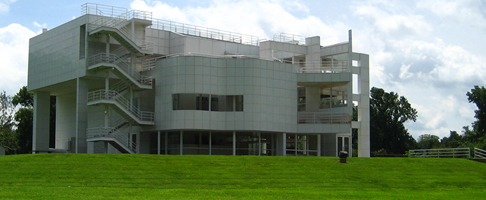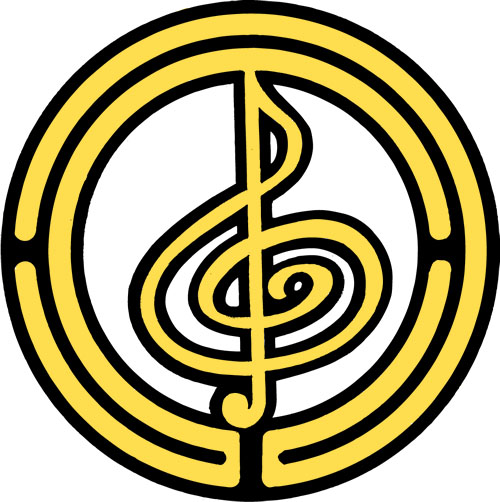

The Atheneum was designed by internationally-known architect Richard Meier. He viewed it as a point of arrival and oriented it towards the riverbank of the Wabash, symbolizing New Harmony’s beginning, as both Harmony Society and Owen-Maclure community members came to the area by boat. To emphasize its function as a public building all spaces not necessarily enclosed, such as the theater, are visible. The glass walls add to the feeling of openness. The large windows are used to frame selected views of the town, relating to the information given to visitors. In its formal structure the Atheneum recalls the 1920s work of French architect Le Corbusier (1887-1965) of the “International Style” school, by its use of ramps, glass walls, columns and graceful curving lines. Meier expanded and manipulated the Modernist architectural vocabulary and evolved out of it a highly personalized style. Planes, columns, and projections are assembled in a complex arrangement. As in his earlier works, square white porcelain steel-backed panels coat the exterior in a grid-like pattern.
A native of New Jersey, Richard Meier gained fame in the late 1960s with a series of pristine white-on-white private houses, of cool, planar-cube-like forms. As he moved to larger public projects he began covering his buildings with metal, the porcelain-coated steel panels, which gave them a taut, gleaming silver and white skin. Meier’s projects from this period include the Bronx Development Center and the Hartford Seminary. In 1982 a line of furniture was produced from his designs. In 1983 his design gave form to the new High Art Museum in Atlanta. It is similar to the Atheneum in its use of white porcelain panels and its series of ramps.
In 1984 Meier won the Pritzker Architecture Prize, often called the “Nobel Prize of Architecture,” which honors the architect’s entire career. With the Frankfurt Kunsthandwerk decorative art museum of the mid-1980s, Meier began to relate his buildings more to their surroundings, especially in terms of building materials. His latest project, the Getty Trust complex of buildings at the foot of the Santa Monica Mountains in California, includes the new J. Paul Getty Museum.
The name Atheneum is derived from the Greek Athenaion, which was a temple in Athens dedicated to Athena, goddess of wisdom and the arts. The temple was a place of learning where philosophy was taught.
Construction of the Atheneum was made possible through a major grant from the Lilly Endowment of Indianapolis and the Kranert Charitable Trust. Ground was broken in 1976 and the building was dedicated on October 10, 1979. The Atheneum has received several awards and international recognition in leading Italian and Japanese architectural publications. In 1979 it received the progressive Architecture Award, and in 1982 the American Institute of Architecture Award.
The Atheneum is located outside the former settlement. A wooden fence indicates the border of the original Harmonist town. It encloses the area where once the Harmonist orchard was located. Because of flooding of the Wabash, the Harmonists did not build or plant any closer to the river.

